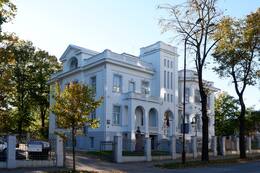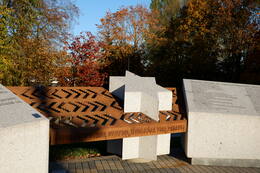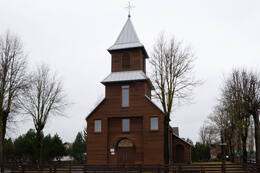Lithuanian rescuers - Miriam Javnaitė-Voronova's survival story
During World War II, Miriam Javnaitė-Voronova survived the Holocaust thanks to many Lithuanians who, risking their own lives and the lives of their loved ones, hid, fed, and cared for persecuted Jews.
"I am one of the few surviving Jews, because we were all condemned to death by the Hitlerites. Closed in the ghetto, in concentration camps, in prisons, hungry, humiliated and trampled like the most despicable creatures on this earth, we did not even have the right to enjoy the sun, although we never blocked it from anyone. Day and night we had to work at the Šiauliai airfield, the Paventiai sugar factory, the Gaudučiai peat bog, the Daugėliai brickyard, on the road section, etc. For this we received heavy beatings and almost nothing to eat. Those horrific images, those nine circles of Dante's hell that we passed through, have not faded from our memory even today.
On the path of my suffering, I met many noble Lithuanians who hid me, clothed me, fed me and supported me morally, risking their own lives and the lives of their families. I would like the names and surnames of all of them, so dear to me, to be immortalized. The pastor of Kužiai (then the chaplain of Šiauliai prison) Požėla Vladas, who helped me and my friend Malinker Zelda escape from the prison where we were sentenced to death; Petrašiūnas, a baker who was in prison because he brought too much bread into the ghetto. He, at the request of the chaplain, saved Zelda; I cannot speak without emotion about the Venclauskas family, who did so much to save as many of our compatriots as possible. In addition, they hid and raised a girl, Chana Blank, who now lives in Israel. In conclusion, I want to say a big thank you to the sons and daughters of Lithuania, who covered our lives with their chests. I am happy to have witnessed the rebirth of Lithuania, thanks to which even a small Jewish nation can be reborn. I wish that the rebirth will grow and strengthen in friendship with the Jewish people.
Related timeline
Related objects
Venclauskiai House-Museum
The Venclauskiai House-Museum is an outstanding example of historical architecture from the inter-war period in Šiauliai. The building, also known as the White Castle, was built for the family of Kazimieras Venclauskas and Stanislava Venclauskienė in 1926 on the land of the former suburb of Šiauliai City. Kazimieras and Stanislava Venclauskiai – members of the Lithuanian national movement and the restoration of the Lithuanian state, are also famous as guardians of many orphans and abandoned children.
During the Second World War, Stanislava Venclauskienė and her daughters Danutė and Gražbylė became famous as rescuers of Jews. Ignoring the fact that, during the war, the German commandant’s office was stationed in their house, they helped the Jews imprisoned in the Šiauliai ghetto by hiding them in the house. Danutė Venclauskaitė had a permit to enter the Šiauliai ghetto, so she secretly brought food and medicine with her when she visited. All three women have been awarded the honorary title “Righteous Among the Nations” and the Life Saving Cross.
In 1991, Gražbylė and Danutė Venclauskaitės donated their family house to the Aušros Museum in Šiauliai. The Venclauskiai House-Museum was opened in 2019 after the reconstruction of the building. The permanent exhibition of the museum tells the story of the Venclauskiai family, while the semi-basement rooms are dedicated to the Holocaust and the rescue of the Jews.
Square for the Righteous Among the Nations (Monument)
On 22 October 2021, the Square for the Righteous Among the Nations (monument) was inaugurated in Šiauliai, at the intersection of Ežero and Vilniaus streets. It is the first monument to the Righteous Among the Nations in Lithuania. The monument was created by the designer Adas Toleikis, a native of Šiauliai, and the idea of the monument was initiated by Sania Kerbelis, the chairman of the Jewish community of Šiauliai County.
The monument “Jungtis” is engraved with the surnames of the “Righteous Among the Nations” of Šiauliai County, thus commemorating 148 Jewish rescuers, while artistic accents mark the gates of the Šiauliai Ghetto. There were two ghettos in Šiauliai: in the so-called Kaukazo Quarter and in the Ežero-Trakų Street Quarter. Physically strong and able-bodied people were sent to the first one, and specialists (doctors, mechanics, etc.) to the second. The Šiauliai Ghetto was established in the summer of 1941 on the orders of the Šiauliai Commandant and liquidated in 1944 with the retreat of Nazi German troops. The remaining Jews were transferred to Stutthof and Dachau concentration camps. More than 5,950 Jews were imprisoned in the Ghettos. During the inter-war period, Šiauliai was home to about 6,500–8,000 Jews, some of whom left voluntarily into mainland Russia. After the Holocaust, there were only about 350–500 Jews left.
Kužių Švč. Mergelės Marijos Gimimo bažnyčia
Darnių proporcijų medinė vienanavė bažnyčia stovi Kužių miestelio centre.
Kužių bažnyčia yra viena nedaugelio šventovių Lietuvoje, kurios taip smarkiai nukentėtų nuo abiejų pasaulinių karų. Mat 1873 m. statyta medinė bažnyčia sudegė per Pirmąjį pasaulinį karą, judant frontui, tad jos vietoje Klebono Adolfo Kleibos rūpesčiu 1920 m. buvo pastatyta laikina.
1929–1932 m. pastatyta nauja masyvi gelžbetoninė bažnyčia. 1944 m. bažnyčia vėl buvo sugriauta praūžusio fronto. Apie 1965 m. buvo išsprogdintos likusios bažnyčios sienos.
2013 m. Kužių bažnyčios 360 metų jubiliejaus proga prie sugriautos bažnyčios mūro liekanų buvo atidengta atminimo lenta, primenanti, jog išlikusios mūro struktūros – 1944 m. per karą sugriautos bažnyčios fragmentai.







